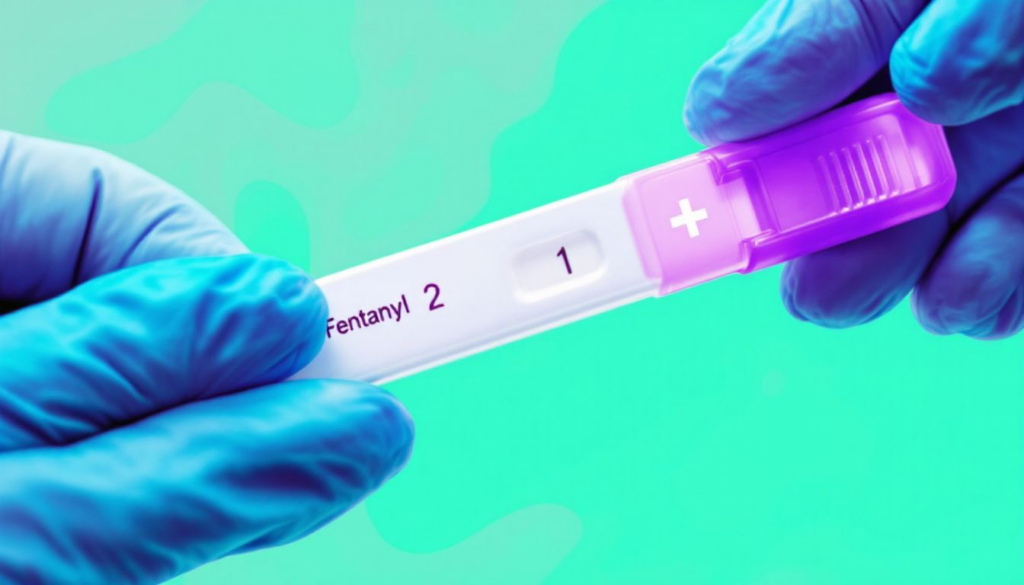Fentanyl does not have a smell. If you’re wondering what fentanyl smells like, the answer is simple: it’s odorless. This lack of scent makes it particularly dangerous because it can be mixed with other drugs without detection. In this article, we will explore the characteristics of fentanyl and the challenges of identifying it, emphasizing the need for safer detection methods.
Key Takeaways
- Fentanyl is an odorless and tasteless drug, making it extremely difficult to detect through conventional methods such as smell or taste, increasing the risk of accidental overdoses.
- Visual identification of fentanyl, especially in counterfeit pills, is challenging due to their similarity to legitimate medications, emphasizing the need for safer detection methods, like fentanyl test strips.
- Harm reduction strategies, including the use of fentanyl test strips and medication-assisted treatment, are vital in preventing unintentional overdoses and supporting recovery for those struggling with fentanyl addiction.
Recognizing Fentanyl by Smell

Utilizing your sense of smell to detect fentanyl is ineffective due to the fact that it is an odorless drug. The absence of a distinct aroma renders this synthetic opioid particularly dangerous since individuals might be unaware of its inclusion in a substance until dire consequences ensue.
The challenge in halting fentanyl overdoses is exacerbated by the drug’s lack of scent, underscoring the urgency for alternative methods that can reliably identify its presence.
Illicitly Manufactured Fentanyl’s Odor
Illicit fentanyl is produced in various forms, including powder and liquid, and it’s commonly combined with other drugs such as heroin or cocaine. These adulterations intensify the effects of these street drugs but simultaneously increase the possibility of a fentanyl overdose. The presence of fentanyl becomes indiscernible through taste or smell due to its mixture with other substances, placing unwary users at grave risk.
Drug dealers are drawn to incorporate fentanyl into their products because it significantly enhances potency. This incorporation turns numerous street narcotics into hazardous traps that could lead to death due to Fentanyl being undetectable by scent or taste, traditional means for identifying drug contents.
Due to irregularities in illegal manufacturing processes, illicitly crafted fentanyl results in unpredictable blends which prevent detection methods while raising the stakes for overdoses caused by unknown potency levels within these deadly concoctions.
Street Fentanyl Variations
The process of manufacturing street fentanyl can result in significant differences from one batch to another. The drug is predominantly without any smell, but it may occasionally exhibit slight odors due to substances mixed during production. These scents cannot be considered trustworthy signs for identifying the presence of fentanyl. Due to the erratic nature of illicit manufacturing practices, even a minimal odor detected does not serve as a reliable indication that fentanyl is present.
Given the mercurial makeup of street-fabricated fentanyl, its use becomes exceedingly dangerous. Individuals who consume this substance are often unaware of what they’re ingesting since distinct batches might vary in strength and impurities. This lack of consistency raises the likelihood of accidental overdoses on this lethal opioid considerably and amplifies the need for more reliable detection tools like fentanyl test strips that can safely determine whether or not fentanyl is contained within a given substance.
Visual Identification of Fentanyl

Efforts to visually identify fentanyl often result in uncertainty, as the substance can manifest either in powder form or as counterfeit pills that closely resemble genuine medications. This resemblance hinders accurate identification of fentanyl through mere visual inspection, leading to potential deceptive appearances. The danger is that various street drugs and imitation pills laced with fentanyl are virtually indistinguishable from the real pharmaceuticals they imitate.
Dependence on just sight for identifying these substances can precipitate hazardous errors. Counterfeit tablets present a significant hazard because they may be almost identical to authorized prescription drugs, tricking individuals into believing what they’re taking is harmless. Such misperceptions sharply escalate the likelihood of unintended overdoses related to fentanyl, underscoring the necessity for more reliable methods of drug detection beyond appearance alone.
Fentanyl Powder Forms
The color of fentanyl powder can span from pure white to a slightly off-white shade. Due to various manufacturing processes, its appearance may greatly differ and complicate efforts to accurately recognize it as fentanyl. The drug could easily be mistaken for other substances frequently encountered in the illicit drug trade. The extremely high potency of fentanyl when found in powder form is especially dangerous because even minuscule quantities have the potential to cause death.
In today’s illicit drug market, stumbling upon fentanyl powder has become alarmingly routine, and its intense strength should not be underestimated. There is an inherent risk that individuals might inadvertently ingest drugs mixed with this substance, which can precipitate severe or lethal overdose incidents. Consequently, there exists an urgent need for effective identification techniques beyond mere visual examination that are essential for safeguarding against unintentional ingestion and averting fatal outcomes associated with this potent drug.
Counterfeit Pills Containing Fentanyl
Fake medications laced with fentanyl are crafted to closely resemble legitimate prescription drugs, posing a challenge for individuals to differentiate based on looks alone. These counterfeit pills duplicate the appearance of well-known medication brands, leading consumers in the wrong direction and increasing the likelihood of unintentional overdose deaths. The striking resemblance between these fraudulent drugs and their genuine counterparts highlights the perils associated with judging them by sight only.
The addition of fentanyl in these imitation pills creates an alarmingly high danger level since even one pill might contain enough synthetic opioids for a fatal dose. Such deceit can culminate in calamitous events like opioid overdose fatalities because users may inadvertently ingest lethal amounts of this potent substance without realizing it.
Given the almost impossible task of visually discerning such risky substances, employing fentanyl test strips becomes crucial as they offer an effective method to uncover if this hazardous component is present within pills—potentially saving lives from accidental drug overdoses fraught with grave consequences.
The Taste of Fentanyl

Using taste to discern the presence of fentanyl is not only ineffective but also exceedingly risky. Fentanyl lacks a distinct flavor, rendering it undetectable by taste alone. This absence of an identifiable fentanyl taste means that individuals are unable to use their sense of taste for recognizing this lethal opioid, which heightens the danger of unintentional consumption and potentially fatal overdose.
Considering how powerful fentanyl is, attempting to detect its presence by tasting or ingesting any unidentified substance can be dangerously ill-advised. Ingestion of even a minuscule amount could lead to a swift and deadly overdose, emphasizing the necessity for more secure methods of detection.
Rather than relying on the hazardous tactic of using one’s palate as a test tool, people should utilize specialized equipment such as fentanyl test strips. These tools provide a crucial safeguard against unwittingly encountering unknown substances that may have devastating repercussions if consumed.
Risks of Tasting Drugs
Utilizing taste as a method to identify drugs is highly risky, especially with powerful substances such as fentanyl. The dangers of tasting even minute quantities of fentanyl are severe due to its extreme potency and the heightened possibility of triggering a life-threatening overdose. Relying on this practice for drug identification can lead to serious health risks and potential fatalities.
Given the acute hazard associated with ingesting fentanyl, which can quickly suppress breathing functions leading to death, it’s crucial that individuals abandon tasting as an approach for detecting drugs. To safely determine the presence of this dangerous substance in drugs and safeguard against its deadly impact, people should employ methods like using fentanyl test strips instead.
Using Fentanyl Test Strips
Fentanyl test strips serve as critical instruments in curbing opioid overdose incidents. They offer a reliable means to identify the presence of fentanyl within a range of other drugs, thereby aiding individuals in averting unintentional overdoses. By using these strips, one can significantly diminish the dangers associated with unknowingly ingesting street fentanyl and consequently suffering an overdose.
Given the variable strength of illicitly-manufactured fentanyl found on the streets, deploying fentanyl test strips assumes increased importance. These tools are capable of revealing traces of fentanyl even when it is present alongside other substances, providing an essential safety measure for users. Despite not being completely infallible, they represent an invaluable component within harm reduction strategies by equipping drug consumers with crucial insights regarding their intake of substances.
How to Use Fentanyl Test Strips
Before: There are a few simple steps to follow when using fentanyl test strips. It’s an easy process to perform. First, dissolve a small amount of the substance in water to create a solution. Next, place the fentanyl test strip in the solution and hold it there for about 15 seconds. The strip will then show if fentanyl is present in the substance. It serves as a detection tool for this specific drug. Make sure the substance is fully dissolved in water for accurate testing results.
After: Here are a few simple steps to follow when using fentanyl test strips:
- Dissolve a small amount of the substance in water to create a solution.
- Place the fentanyl test strip in the solution and hold it there for about 15 seconds.
- Check the strip to see if fentanyl is present in the substance.
Make sure the substance is fully dissolved in water for accurate testing results.
Following these steps ensures effective use of fentanyl test strips to detect its presence in drugs. This method provides a reliable way to identify fentanyl and reduce the risk of accidental overdose, making it an essential tool for anyone concerned about the potential contamination of their substances.
Benefits of Harm Reduction Strategies
Employing harm reduction strategies is critical in mitigating adverse health consequences linked to drug use. Such measures are designed to lessen the dangers of overdose and other detrimental outcomes, equipping individuals with the necessary resources and knowledge for safer decision-making regarding drug consumption. The utilization of fentanyl test strips stands as a principal measure within these strategies, providing users the ability to ascertain if their drugs contain fentanyl, thereby circumventing unintentional overdoses.
The introduction of fentanyl test strips into communities can notably reduce instances of overdose deaths. By enabling individuals to identify the presence of fentanyl within their substances, these strips serve as lifesaving tools that alert users about potential risks before consumption.
It’s vital for maintaining community safety that harm reduction approaches persistently include elements such as fentanyl test strips. These methods play an indispensable role in safeguarding those who partake in drug use by curbing potentially lethal encounters with tainted substances.
Signs of Fentanyl Exposure and Overdose

It’s essential to acknowledge the symptoms of fentanyl exposure and overdose quickly for appropriate and swift action. Manifestations such as dizziness, suppressed breathing, and skin rash signal the urgency of seeking immediate medical attention. Given that a minimal quantity of fentanyl can result in significant damage or be lethal, it is crucial to recognize these signs promptly to avoid tragic outcomes.
Symptoms of Fentanyl Exposure
Manifestations of fentanyl contact can vary from minor to critical, with common signs including dizziness and reduced breathing function. Additional symptoms could consist of a skin rash along with various bodily responses. Early identification of these signs is key in influencing the result, since rapid medical response can hinder Issues and be life-saving.
It is essential for both individuals who use fentanyl and their associates to recognize the symptoms associated with its exposure. Immediate medical care should be sought if there’s any suspicion of someone encountering fentanyl, as this action is vital in averting a potentially fatal overdose.
Immediate Actions During an Overdose
Should someone exhibit symptoms indicative of a fentanyl overdose, such as pronounced respiratory distress or lack of consciousness, it is critical to take immediate action. The first step should be to summon emergency services to guarantee the arrival of professional medical support. In cases where naloxone is accessible, administer it without delay in order to counteract the toxic effects associated with an overdose. Despite its potential for saving lives, expedited access to medical care remains imperative.
While naloxone has the capability to momentarily halt both a fentanyl and opioid overdose’s detrimental impacts, this measure does not replace expert medical treatment. It is essential that you reach out for emergency medical personnel and ensure that comprehensive care is provided promptly so as to prevent enduring health issues and maximize recovery prospects.
Understanding Fentanyl Addiction

Addiction to fentanyl is a serious and intricate issue that necessitates thorough comprehension and multifaceted approaches for intervention. It’s imperative to acknowledge the psychological as well as physiological indicators of addiction to ensure prompt assistance and therapeutic measures.
Substantial alterations in an individual’s behavior, social exchanges, and overall physical wellbeing can result from dependence on fentanyl. Pinpointing these symptoms promptly is vital for effective identification.
Behavioral Indicators of Addiction
Indicators such as shirking duties, heightened levels of privacy, and distancing oneself socially can suggest an addiction to fentanyl. Alterations in how one sleeps and interacts with others often accompany these behaviors, signaling a strong possibility of dependency that necessitates prompt action and aid.
It is critical for both individuals and their close associates to acknowledge these shifts in behavior promptly. Detecting the signs early can facilitate intervention at an opportune time, which is essential in averting the grave repercussions associated with an addiction to fentanyl.
Physical Symptoms of Withdrawal
Withdrawal from fentanyl can be a profoundly difficult experience, characterized by severe symptoms such as:
- Aching muscles
- Queasiness
- Powerful urges for the drug
- Sleeplessness
- Upset stomach
The intensity of these physical manifestations emphasizes the heavy burden that addiction to fentanyl imposes on one’s body.
The harshness of withdrawal experiences, which includes significant muscle discomfort and relentless sleep disruption, underscores the importance of medically supervised detoxification. Adequate medical attention is essential in alleviating these distressing symptoms and in addressing severe pain. It also offers critical support necessary to overcome an addiction to fentanyl successfully.
Treatment Options for Fentanyl Addiction
An effective approach to tackling fentanyl addiction usually involves an integrated mix of medical interventions, psychological support, and social assistance. Catching signs of addiction early can greatly improve the likelihood of successful treatment outcomes. For instance, Southeast Detox offers both a medical detoxification process and residential treatment options that create a supportive environment conducive to recovery. These approaches typically encompass individual therapy, group sessions, as well as participation in 12 Step programs aimed at addressing different dimensions of substance abuse.
Peer-led support circles like Narcotics Anonymous and SMART Recovery are integral to the rehabilitation journey by offering consistent backing and fostering community among those battling with substance use disorders. By weaving counseling services and peer support into their comprehensive treatment plans, these programs equip individuals with necessary coping mechanisms and fortitude essential for achieving lasting sobriety.
Medication-Assisted Treatment (MAT)
The approach known as Medication-Assisted Treatment (MAT) is a well-supported method that amalgamates the use of medications with counseling and behavioral therapies to address opioid use disorder. MAT aids in helping individuals abstain from drug use, alleviate cravings, and diminish withdrawal symptoms – establishing itself as an integral part of comprehensive addiction care strategies. Suboxone is frequently utilized in MAT regimens for its ability to thwart opioid effects while mitigating withdrawal discomforts.
By offering a solid base for patients during their journey towards recovery, MAT markedly enhances the likelihood of successful outcomes. As it tackles both the physical dependency and psychological challenges associated with addiction, MAT delivers a thorough route to healing that paves the way for enduring transformation.
Counseling and Support Services
Effective addiction treatment programs hinge on the inclusion of counseling and support services. The advantage of inpatient rehabilitation is its immersive, distraction-free setting that fosters recovery. Such programs equip individuals with essential resources and backing to conquer their addictions and establish robust coping strategies.
Crucially, both individual and group counseling within support services tackle the root causes fueling an individual’s addiction. These elements constitute a critical aspect of the recuperation journey by fostering a supportive network accompanied by expert advice, thereby assisting people in laying down a solid groundwork for sustained abstinence from substances.
Summary
Grasping the risks associated with fentanyl is essential for averting overdoses and aiding those battling addiction to this lethal opioid. The lack of taste or smell in fentanyl compounds the challenge of identifying it through conventional means, underscoring the need for tools like fentanyl test strips that provide more definitive detection. Due to its potential presentation as a powder or within counterfeit pills, attempting visual identification alone proves unreliable.
Comprehending both signs indicative of someone encountering fentanyl and recognizing addiction behaviors—as well as withdrawal symptoms—is critical for quick and effective action toward their recovery. A combination of treatment strategies such as Medication-Assisted Treatment (MAT) along with counseling services can facilitate individuals overcoming their struggles with fentanyl dependence, thereby reclaiming stability in their lives. Informed utilization of harm reduction tactics allows collective efforts towards diminishing the tragic toll that fentanyl inflicts on communities.
Frequently Asked Questions
What does fentanyl smell like?
It is essential to exercise caution with fentanyl, as it has no scent and cannot be identified by smell. This odorless nature of the substance makes detection solely through olfactory means impossible.
How can I visually identify fentanyl?
Identifying fentanyl visually is difficult because it can be found in different forms, including powder and counterfeit pills that mimic real prescription drugs.
For precise identification, chemical testing should be employed instead of relying on visual indicators.
Is it safe to taste drugs to identify them?
No, it is not safe to taste drugs for identification, as this method can be extremely dangerous and even deadly, especially with substances like fentanyl that are indistinguishable in taste.
Always prioritize safety and seek professional help for drug identification.
How do fentanyl test strips work?
Fentanyl test strips work by detecting the presence of fentanyl in a dissolved substance. Simply mix a small sample with water, dip the strip, and wait for the results to ensure safety.
What are the treatment options for fentanyl addiction?
Treatment options for addiction to fentanyl include Medication-Assisted Treatment (MAT), along with counseling, support services, and residential rehab programs.
Such approaches cater to the complex aspects of substance dependency by facilitating recovery on both a physical and mental level.

Mitchell Grant Cohen
Dr. Mitchell G. Cohen is a board-certified Internal Medicine specialist with over 34 years of experience in patient-centered healthcare. A graduate of Hahnemann University School of Medicine, Dr. Cohen completed his internship at the University Health Center of Pittsburgh, where he gained invaluable hands-on experience. He is also a certified addiction specialist, holding membership with the American Society of Addiction Medicine (ASAM).
Currently based in Nashua, NH, Dr. Cohen is affiliated with Saint Joseph Hospital, where he provides comprehensive care focusing on both internal medicine and addiction treatment. His expertise includes prevention, diagnosis, and management of adult diseases, as well as specialized care for individuals facing substance use disorders.
Dr. Cohen is committed to fostering open communication, ensuring his patients are fully informed and empowered to make confident decisions about their health and treatment options.





